We also got to see the 'Laura Ashley' collection, which runs until 05th January 2014 and the Arthur Blackborne lace collection.
Here is some of the garments that have been donated to the museum for their permanent fashion and textile collection;
1958 Evening Dress made in a Cream Silk Satin. British. Designed by Victor Sleibel, London. Presented by the Lady Davina Barnard, 2005.
1950's Evening Dress, made by Belinda Bellville. British.
1950-5 Longline Strapless Bra, Nylon Machine Made lace. British. Made by Spencer. Presented by Mrs Spargo Taylor, 1974.
1950-5 Cinch Corset by Triumph. Perlon and Nylon machine made lace, elastic. Size 23. Presented by Mrs Linda Drury, 2001.
1957 Cocktail Hat. Black un-curled Ostrich feathers. Designed by Simone Mirman for Christian Dior. Worn by Lady Pamela Haverlock Allen.
1960 Suit by Norman Hartnell. Bright Blue Wool Tweed, with Black leather trim and metal fastenings. British. Presented by Mrs R.S. Stephenson, 1976.
1965 Hair Piece. A Brown ponytail made of human hair, probably exported from Hong Kong. Presented by Julia Raw, 2003.
1964 Orange Soft Suede Hat. Originated from a London Carnaby Street manufacturer. Presented by Julia Raw, 2003.
1964 Dress by Jean Varon. Blue Silk Mousseline with daisy flower trimmings. British. Presented by Julia Raw, 2003.
1965 Black and White Cotton Print Dress with plastic hoops. Presented by Mrs M Smith, 1982.
1970 Man's Suit. Single Breasted, bottle green Velvet. British. Made by Village Green (Kings Road, Chelsea). Presented by Mr Eddie Ryle-Hodges, 1981.
1940-6 Black Crepe Evening Dress with Net Bodice and printed crepe de chine. British. Presented by Mrs J Campbell, 1991.
1941-8 Utility Suit. British. Armar model with the utility mark CC41. Presented by Mrs Fairclough, 1975.
A blouse from the same time frame, that would be worn under the jacket.
Not a great image, I've tried to get a better close up below.
1930-1932 Silk Crepe Evening Dress, trimmed with diamante. British. From Bradley's, London. Presented by Mrs R S Stephenson, 1976.
1932 Crepe backed Silk Satin, Evening Dress. French or British. Presented by Mrs R S Stephenson, 1976.
1890's Man's Hunt Dress Coat of the Zetland Hunt, with waistcoat and breeches. It is made from Red Wool Superfine and a silk velvet collar, brass buttons marked with a Z and coronet. Its lined with a cream and red checked wool. The waistcoat is of yellow wool edged with velvet. Buff leather breeches. Made by Marshall & Co, London.
1919-25 Evening Coat. Cotton embroidered with glass bugle beads, labelled 'Made in France'. Presented by Mrs H Kenyon-Fuller, 1982.
1925-1928 Evening Dress. Blue Silk Georgette and devore silk velvet with applied velvet flowers on front skirt. British. Presented by Miss S Riley-Lord, 1984.
1925 Hat made of Marquetry, Kingwood, Boxwood and Leather. French, Jeanne Menault, Paris. Presented by Fenwick Ltd, 1964.
1925 Hat, Baku Woven Straw, darned embroidery using coloured wool's, trimmed with silk chiffon. British. The Sagwen Hat, London & Paris. Presented by Miss L Errington, 1968.
1925 Dress, Wool Crepe, printed. Typical of new style at that period. British. It's the dress Miss L Errington wore with the above hat.
1916- Wedding Suit, Cream twilled wool, corded silk collar and cuffs. British. Presented by Miss F Storey, 1968.
1919-1920 Woman's Suit, wool gabardine, lining of printed silk satin. A masculine tailored style that was first introduced to women for outdoor activities such as cycling.
British. Bequest of Mrs M S Gordon, 1963.
1910-12 Dress, Cotton with woven blue stripe and Irish Crochet. A summer time outfit, features cutaway jacket and narrow skirt, with decorative buttons and Magyar sleeves.
British. Bequest of Mrs M S Gordon, 1963.
1904 Ribbon Corset. These were usually lightweight and short with bones at the side and front. They were usually worn informally or for sport. Made in Ivory Silk Satin.
1895- Tailor Made Costume. Wool, with velvet collar, trimmed with wool astrakhan. Fashionable feature's include the high collar, large 'Gogot' sleeves, narrow waist, gored skirt with pleats at the back and applied trimming. British. G & A Cooke, Durham. Presented by Mr D J Smith, 1994.
1878 - 80. A morning or seaside dress, made of cotton sateen, printed with a design of cupids and pink roses. The front panel is ruched and the drapery swathes round to the bustle at the back. British. Presented by Mrs A Roberts, 1974.
1880 Wedding Dress. Creamed silk trimmed with satin bows, silk net, artificial flowers and pleated frills at lace edged hem. British.
1874 Dress. Smart Day Dress, with fitted Jacket Bodice and full skirt, concentrated towards the back, by means of inside tapes, worn over a bustle. Made in dark and light blue silk. British. Presented by Miss O.E Brackenbury, 1962.
Reproduction of 1870's Corset. Made by hand and on a period sewing machine, in exactly the same way it would have been made and using similar materials. Blue Silk Satin. Italian. On loan from maker, Luca Costigliolo.
1875 Bustle - Steel wires, cotton. British. Langtry Bustle (named after the popular actress of the time, Lillie Langtry). Presented by Miss O.E Brackenbury, 1962.
1869 Crinoline. Watch spring hoops covered in cotton braid. Thomson's No.272 Empress. British. Presented by Mrs P Pease, 1967.
1832-70 Livery Buttons for Emperor Napoleon III of France. Gilded Brass.
1858-60 Jacket. Silk, embroidered in gold and silver metal thread of different types, sequins and gold lace. Silk lining hand quilted. This jacket was know as a 'Paletot', a loose shaped design to be worn over a full skirt supported by a crinoline. French. The Empress Eugenie Collection. Presented by Miss E Edleston, 1959.
1857-60 Day Bodice. Purple Silk, black silk velvet and black lace. French. The Empress Eugenie Collection. Presented by Miss E Edleston, 1953.
c. 1868 Walking Dress. Green silk, warp-printed trimmed with silk braid and fringe. It is an example of the passion for strong colours made from the new dyes of coal-tar aniline. Under the skirt was a hooking system by which the hem was able to be raised up to prevent it trailing on the ground, particularly when playing croquet. British. Presented by Mrs Gill, 1972.
1863 Dress. Blue and Ivory Silk, trimmed with silk bows, fringing and tassel's. This is a example of gored skirts over the crinoline which transforms the female silhouette into a wide based triangle.
British. Presented by Lady Dillon, 1971.
1856-57 Dress. Pale blue silk, with white stripes woven a disposition (to shape), trimmed with silk fringe and tassel's, lace collar and under sleeves added. The boned bodice has wide pagoda sleeves and the skirt has been increased by flounces, which give greater fullness to the skirt without the need to add more fabric at the waist. British. Presented by Miss O.E Brackenbury, 1962.
1855-60 Dress Flounce. Black grenadine silk bobbin lace, Chantilly-type. Belgian/French. Blackborne collection. Dr and Mrs E.G.F Tinsley.
c. 1855, Matching Day and Evening Bodices. Often dresses would have two bodices to match a skirt. The jacket style as day wear, with pagoda sleeves and the evening bodice has shorter sleeves and lower decolletage, behind the ribbons would have been lace or tulle. Made of Silk, chine (warp-printed), trimmed with silk blonde lace. French. The Empress Eugenie collection. Presented by Miss E Edlestone, 1959.
1842 The wedding outfit of Samuel Wise. A double breasted cut-away dress coat, made from wool facecloth edged with wool braid and gilt buttons. A single breasted waistcoat made from woven figured silk with floral sprigs. The stock and cravat are silk twill, pleated. The pair of trousers are twilled wool facecloth, with an elastic strap under the instep.
1842 Man's Corset By Henry Adcock. This would be part of the wedding outfit. The corset laces up at the centre back where it is stiffened with two strips of whalebone. Additional side lacing make it adjustable over the hips. The buttons at centre front enable the wearer to take it off without undoing the laces.
Made from cotton sateen, linen canvas, suede leather, linen twill tape, cording, metal springs and whalebone.
1842 Man's Cloak, part of the wedding outfit. Made from wool facecloth, collar of astrakhan sheepskin, lined with glazed wool twill. Fastened at neck with metal clasps and horsehair cords with tassel's.
1835 Outdoor Bonnet. Made from Gold Silk, trimmed with figured silk ribbons and velvet.
British. Presented by Mrs P Lawford, 1986.
1833 - 1835 Boy's Tartan Dress. Young boys often wore a dress or tunic with a pleated skirt, mainly made of a chequered wool, up to the age of 7. This example was made of wool, woven check, the bodice was lined with red silk. British. Presented by Mrs M Turner, 1984.
Indoor cap
1815- 1820 Dress. A cotton muslin dress with a good example of the whitework embroidery and needlelace fillings produced by the factory workers at Ayr, Scotland. Presented by Miss H.S. Alderson, 1982.
1836-38 Printed Muslin Dress. Fabric 1790 - 1818.
The fabric must have been highly prized as this dress was re-made from an earlier dress and is well worn.
British. Cotton Muslin, hand blocked print with a pencilled blue and black silk net collar.
The Henry Poole & Co Collection
Oh there's just something about a man in uniform........
2010 'Old Style' Velvet Court Dress Uniform. Made of Blue and Black silk and cotton velvet, lined silk. Copper alloy buttons in imitation of cut steel. Cut Steel small sword c.1890.
c.1930 'New Style' velvet court uniform. Blue and black silk and cotton velvet, lined silk. Copper alloy buttons in imitation of cut steel. A plainer style, with a cut away coat.
1850 Court Dress. Superfine wool cloth, lined silk, cut steel buttons, white silk waistcoat embroidered with coloured silks.
1780 Court Dress (Not Henry Poole). Cut and un-cut velvet, embroidered with coloured silks and applied net. This net is an early example of machine net, made on a warp frame. The silk waistcoat is from another court dress of a similar time frame but has an altered collar. The coat has had buttonholes added at a later date.
1927 Mrs Nicholl's Livery. Blue and yellow broadcloth, with copper gilt buttons.
This was made for Footman Stapleton, it is an example of livery from the Middle Classes. It was usual for old aristocratic household's to retain the 18th Century style livery garments for State or other Ceremonial purposes.
1920 Privy Councillors Full Dress Coatee, Sword and Cocked Hat.
Blue-black superfine cloth, lined silk; copper gilt buttons. Embroidery of silk-gilt purl, passing thread and spangles. This lavish embroidered design of stylised oak and palm branches might take between 4 to 6 months to complete; the garment passing between the cutting room floor and the embroiderer's workshop.
1923 Japanese Ministerial Uniform, Sword and Cocked Hat.

Now for a man in a suit.....
I love the colour of this blazer.
Very 'Dr Who'
Oh 'James Bond' styleee, lovely...
A fantastic exhibition to see, all the staff at Henry Poole are so talented and must have lots of patience.
And Finally, 'The Romantic Heroine, Laura Ashley'.
These dresses were worn by lots of women in the 1970's but the majority of them had a distinct Regency and Victorian element to them incorporating a 'seventies' vibe.
Bowes Museum is a fantastic estate to visit if you are in the area, the town that it is situated in, is beautiful and quaint.
Should you like to visit the address is:
Bowes Museum
Newgate
Barnard Castle
County Durham
England
DL12 8NP
or alternatively visit their website:
www.thebowesmuseum.org.uk
A big Thank You goes to Bowes Museum, for allowing us to take these photo's, which I can assure you do not do the garments the justice they deserve.
































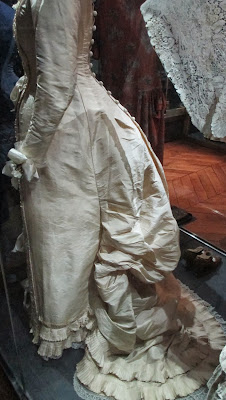
















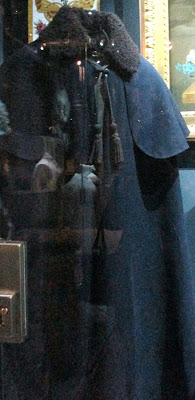


















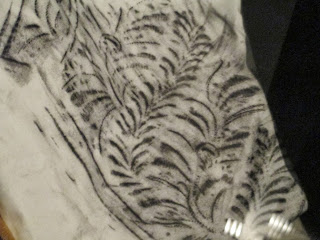


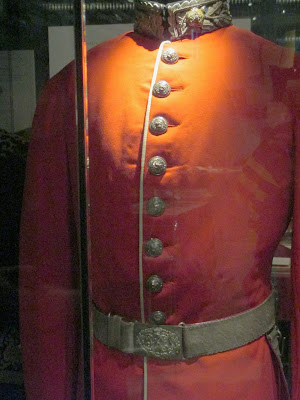






























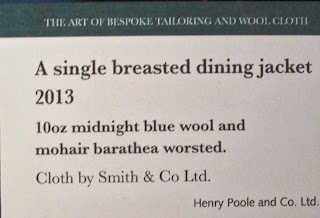










No comments:
Post a Comment